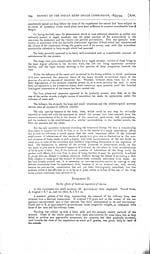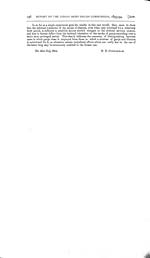Medicine - Drugs > Report of the Indian Hemp Drugs Commission, 1894-1895 > Volume III
(199) Volume 3, Page 195
Thumbnail gallery: Grid view | List view

REPORT BY BDE-SURGN.-LIEUT.-COL. D. D. CUNNINGHAM, F.R.S., C.I.E. 195
The experiment was begun
on the 31st October 1893 and continued until the 6th Jan-
uary 1894, and during this period doses were administered on 62
days. The original small
doses were employed until the 12th November when the amount was
somewhat increased.
On the 25th November the dose was raised to 0.52 grain, on the 28th
December to 2 grains
and on the 30th December to 3 grains.
No conspicuous effects
manifested themselves during the entire course of the
experiment.
At the outset the animals appeared for a time to be somewhat
quieter than they had been
previous to the administration of the drug, but, if this were in
any way a consequence of the
treatment, it was one of very transitory nature as it soon wore
off, and during the whole of
the latter part of the course of the experiment they appeared to be
entirely unaffected in any
way, and were quite lively. Their appetite for food underwent no
appreciable alteration
throughout.
The rapid and
considerable increases in the amount of doses of the drug which
were
latterly made unfortunately had the effect of bringing the
experiment to an abrupt and
untimely termination, for after they had for a few days partaken of
doses of 3 grains both ani-
mals simultaneously absolutely declined to touch the milk
containing the drug, and, in spite of
repeatedly renewed attempts to induce them to resume the habit,
they have persistently refused
to do so up to the present time. They were therefore only under
treatment from the 31st
October until the 6th of January, which was the last day on which
they could be induced to
partake of the milk, and the only noteworthy phenomenon which
presented itself during the
entire course of the experiment was the abruptness with which an
extreme distaste for the
drug set in. This is the more remarkable when compared with the
phenomena which presented
themselves in connection with continued treatment by inhalations of
ganja. In the case of
the ingestion of charas continued treatment was accompanied with
the development of a dis-
taste for the treatment, whilst in the case of ganja-inhalation it
led to the acquisition of an
abnormal craving for it.
EXPERIMENT III.
On the effects of habitual inhalations of the smoke of the seeds and leaves of dhatura.
The subject of
experiment, as in the case of that on the effects of the inhalation
of the
smoke of ganja, was a fair-sized specimen of Macacus rhesus.
The treatment was initiated
on the 1st June and continued until the 11th July, so that the
experiment lasted for a period
of about six weeks. In its conduct the same inhalation-apparatus
was employed as in the first
experiment. At the outset the seeds of dhatura were made use of as
the source of smoke,
but as the latter appeared to be undesirably potent, leaves were
presently substituted for
them and were persistently employed throughout the rest of the
experiment.
The symptoms attending
the treatment were not invariably quite uniform in character.
On some occasions indications of a certain amount of cerebral
excitement were present for
some time, but as a rule drowsiness and gradually increasiug
intoxication manifested themselves
from the outset, either alone or associated with symptoms of
irritation of the respiratory
apparatus as indicated by coughing.
The animal was killed by
means of prolonged administration of chloroform on the morn-
ing of the 14th July and a post-mortem examination conducted
at once with the following
results:
The lungs were not
adherent to the thoracic walls,but were both deeply congested
almost
everywhere, and specially towards their apices in which numerous
tubercular nodules and
small cavities were present. Such phenomena are, of course, very
frequent in the lungs of
monkeys in confinement, but it remains possible that the general
pulmonary congestion may
have been partially due to irritation incident on the inhalation of
the smoke. The visceral
pericardium was almost devoid of fat and was somewhat thickened and
opaque, especially
over the region of the right auricle. The omentum and mesentery
were also very free from
fat. The spleen appeared to be rather anæmic and was somewhat
fibroid in texture. The
liver, pancreas, stomach, large and small intestines, and kidneys
presented no abnormal appear-
ances.
On opening the cranium
the dura-mater was found to be somewhat thickened and, es-
pecially in the neighbourhood of the superior longitudinal sinus,
very conspicuously congested.
In this region, too, the membrane in the occipital region was fixed
to the cranial walls by soft,
very vascular adhesions. The pia-mater was thickened and so highly
injected throughout
that the cerebral surface had a generally diffused pink tint. The
cerebral substance was every-
where abnormally soft and so friable as to render any immediate
removal of the membranes
impossible without the occurrence of much destruction of the
nervous tissue. Like the sur-
face, although in minor degree, it was of a pinkish tinge owing to
abnormal accumulation of
blood. Conditions of this kind appeared to be universally diffused
throughout the whole of
the cerebral centres, the texture of the hemispheres, of the
cerebellum and of the basal ganglia
being alike soft, and the evidences of abnormal congestion
universally distributed. In spite
of this, however, the spinal cord and its membranes were to all
appearance perfectly
healthy.
Set display mode to: Large image | Zoom image | Transcription
Images and transcriptions on this page, including medium image downloads, may be used under the Creative Commons Attribution 4.0 International Licence unless otherwise stated. ![]()
| India Papers > Medicine - Drugs > Report of the Indian Hemp Drugs Commission, 1894-1895 > Volume III > (199) Volume 3, Page 195 |
|---|
| Description | Volume 3: Appendices. Miscellaneous. |
|---|---|
| Attribution and copyright: |
|




